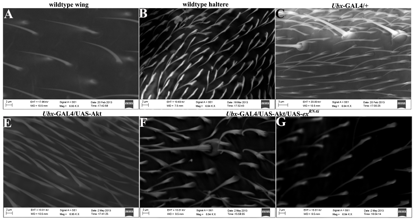lab members working on this project
OPEN POSITION!!
Past : Savita Singh
Critical role for Fat/Hippo and IIS/Akt pathways downstream of Ultrabithorax during haltere specification in Drosophila
This project aims to study Ubx-mediated regulation of the Fat/Hippo and IIS/dAkt pathways, which control cell number and cell size during development. We have observed that over-expression of Yki or down regulation of negative components of the Fat/Hippo pathway, such as expanded, caused considerable increase in haltere size, mainly due to increase in cell number. These phenotypes were also associated with the activation of Akt pathways in developing haltere. Although activation of Akt alone did not affect the cell size or the organ size, we observed dramatic increase in haltere size when Akt was activated in the background where expanded is down regulated. This was associated with the increase in both cell size and cell number. The organ appeared flatter than wildtype haltere and the trichome morphology and spacing resembled that of wing suggesting homeotic transformations. These results suggest a link between cellular growth and pattern formation and the final differentiated state of the organ. One possible mechanism that we would like to investigate is linking Fat/Hippo pathway to mechanical forces that cause bulging (as in halteres) or flattening (as in wings) of epithelial cells.

Upregulation of IIS/dAkt and Fat/Hippo pathways causes haltere-to-wing homeotic transformations at the level of organization of the epithelial cells. (A) SEM image of a representative area of wildtype wing blade. Note, long thin trichomes, which are sparsely arranged (B-I) SEM images of representative halteres of various genotypes as shown on the images. Note near complete transformation of trichome arrangement in halteres over-expressing dAkt in the background of down regulation of ex.